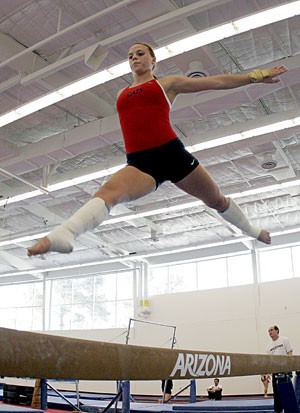Injuries are synonymous with athletics.
Every day the Arizona Athletics medical staff in McKale Center is deluged with members of the No. 18 Arizona gymnastics team seeking treatment.
Some have stress fractures or sprained ankles, while others have broken fingers sustained from awkward landings or falls.
Then there is Bree Workman, whose medical maladies are anything but common.
Workman, a junior from Lansing, Mich., came to Arizona as an accomplished multi-sport athlete. She holds two varsity high school track records in the 4×100- and 4×200-meter relays and was the 2003 Division I Michigan high school state champion in the gymnastics all-around competition and on the beam.
In 2004, the fascia, or sheath, over the muscle in her left arm tore and she underwent surgery to correct it. The surgery failed. Workman underwent a second surgery in 2006, leaving her with a potentially devastating condition. Workman’s left hand no longer functions.
“”I can’t hold a hairdryer or anything and have to do everything with my right hand,”” Workman said. “”It’s really, really frustrating for me and my coaches because I feel like I had no control over my body. It’s not like ‘Ow, this hurts, I’ll just take some Aleve.’ My arm just won’t work.””
Last week, a nerve study came back showing no permanent damage. Trainer Doug Cantaoi said doctors diagnosed Workman with exercise induced cubital-tunnel syndrome, a condition where the muscle puts pressure on the ulnar nerve, causing numbness.
Cantaoi said the UA coaches have done a great job accommodating Workman’s issue by keeping her reps down and keeping her on the floor.
Workman compared the numbness to waking up with a “”dead arm.””
“”That’s what happens to me,”” she said. “”Except I can’t move my hand or forearm.””
After this season is over, she will take a month off to see if the numbness is caused by gymnastics. If the numbness continues, she will get a nerve decompression in which doctors would cut into the nerve and attempt to release the pressure.
“”I’m really hoping it is (related to gymnastics),”” Workman said. “”I really try to take it one day at a time because some days (my arm) works and some days it doesn’t.””
And to compound matters, in January 2006 she began suffering from vocal cord dysfunction.
Often misdiagnosed as exercise-induced asthma, VCD is a spasm in the vocal cords causing them to squeeze and eventually shut.
“”When I’m in a full attack, it’s like my body is suffocating itself,”” Workman said.
VCD is triggered by many different allergens, and in Michigan, Workman felt no effects. It wasn’t until she came to Tucson that she began experiencing symptoms.
“”We don’t have any of the same plants or weeds (in Michigan) and my trigger is actually being in Arizona, which is kind of ironic,”” she said.
Despite being an accomplished all-around high school gymnast, she was unable to compete on the beam or bars because of her nerve problems and the VCD almost ended her career entirely.
After a floor routine in 2005, Workman experienced a full attack, which scared her teammates and coaches as much as it scared her.
“”She would turn purple,”” said UA head coach Bill Ryden. “”Literally, there were times when our trainer was freaking out and about to call 911 because we couldn’t get air into her.””
“”It was scary,”” said senior Karin Wurm. “”None of us had ever seen anything like that before.””
Usually after a floor routine, Workman would “”lay on the ground and have mini-seizures, sucking in so hard for air that (her) body would start convulsing.””
For the remainder of that season, Workman was reduced to a vault-specialist, and even then she wasn’t immune from the attacks.
She would make a vault, then wait 10 minutes to catch her breath before the next vault or she ran the risk of having a seizure.
“”It was really frustrating,”” Workman said. “”I was wondering why this was happening. It wasn’t until after I had gone to a speech therapist to learn how to breathe and talk differently that I began to get some control on the attacks.””
Ryden agreed Workman’s health issues were very frustrating.
“”She’s got such power (in her legs) that of course she would be good on floor,”” Ryden said. “”But if you’re gonna faint halfway through the routine because you have no oxygen, what good are you?””
During the start of the 2007 season, Workman finally returned to the floor during meets. After one meet, Workman’s mother, Beth, began crying after watching Bree compete on floor.
“”I never thought I’d see you do floor again,”” she said to her daughter. “”I’m just so happy that you’re out there again.””
She has come a long way from lying on the floor of her speech therapist’s office learning to control her breathing and being hooked up to oxygen machines.
Now she is one of the Gymcats’ best and most relied-upon vaulters and floor workers, receiving scores in events she never knew she would compete in again.
“”Everything happens for a reason,”” Workman said. “”I don’t know what this reason is, but maybe it’s to show people to keep fighting and don’t give up. Maybe one day you’ll be doing things you never thought you’d do. I just take a deep breath and I let my body do what it does and try not to have it tear me in the wrong direction.””









